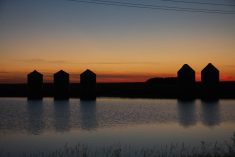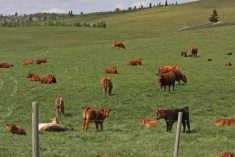PIERSON, Man. – There are plenty of horse lovers on the Prairies. While few dispute the practical benefits of owning a good Quarter horse for rounding up cattle, most draft horses on Canadian farms spend their days loafing about and eating hay.
Perhaps the main reason they aren’t put to work, other than occasionally pulling the sleigh or wagon when the weather is good, is that most of the horse-drawn equipment available is either so old and rusty as to be beyond use, or in some cases, still waiting to be invented.
Read Also

Know what costs are involved in keeping crops in the bin
When you’re looking at full bins and rising calf prices, the human reflex is to hold on and hope for more. That’s not a plan. It’s a bet. Storage has a price tag.
So when Todd Daniels’s father Neale, who has worked with horses since he was eight years old, asked him to build a sleigh that could handle big round bales, Todd started working.
He came up with a wide-bodied, two-seater sled with a hydraulic grapple. A 12 volt battery runs the hydraulic power pack, which at the touch of a button grabs onto a bale and lifts it off the ground.
The bale can then be taken to the feeding yard, where the twines are removed, and then lowered to touch the ground and neatly unrolled for the cattle.
With a good team, backing up into a bale is no problem. In fall or spring, when there’s not enough snow, wheels can be bolted onto the runners, and two free-steering caster wheels put on the front. His father prefers the wheeled version, while Todd likes the runners.
It worked so well that Todd, who farms with his wife Heather and their two children, now leaves his tractor in the shed for most of the winter.
“I had never driven horses much until I built this one for Dad. Then I saw how nice it was to feed the cattle with horses,” he said. “I kind of fell in love with it. Now I’ve got a team of Percherons of my own that I’ve been using to feed the cattle with for three or four years.”
Daniels, who along with his father owns 220 head of mostly Charolais cattle on a farm first settled by his forebears in 1882, started manufacturing prototypes, calling it the Daniels Balesled.
When BSE came along and cattle prices plunged, he figured the time was right to start selling his invention as a sideline.
“I figured that I might make a few extra bucks, but it turned out that the people I was trying to sell them to didn’t have any money either,” he said, laughing.
The units, which he retails for $7,000 each, depending on options chosen, including an AM/FM radio, have generated interest among the draft horse niche. Of the 10 that he has built, four have found buyers in Canada and the U.S.
“You have to be a little more dedicated to use horses every day, but you can feed with horses just as fast as you can with a tractor. It does take a few more minutes to harness up, and you have to look after your horses a bit more in winter, but you can save $100 a week on diesel fuel.”
For half as much as the cost of a new loader for a tractor, Daniels said the Balesled can do the work of feeding cattle just as well as a front-wheel assist tractor and a tub grinder combined.
In some ways it is superior, since unrolling the bales means less forage gets turned into dust.
When the snow is deep, his Percherons just bear down and pull harder.
Neale, 68, who uses his Balesled 200 days of the year, said horses benefit from being put to work daily. Humans, too.
In the race to make money that is farming these days, it’s easy to forget to stop and smell the roses.
“There’s two things that I like doing, feeding cows and driving horses,” he said. “That’s why I do it.”
Neale recalled a bad winter years back, when the snow was deep and it was hard to get bales to his bulls.
“We would be two hours just moving snow so we could get the tractor in,” he said. “I thought to myself, why don’t we just harness up the team and drive over that snow?”
Neale remembers when tractors started replacing horses on farms in the 1950s. Thinking back, he said, it didn’t make sense in some ways. The old tractors didn’t have cabs, so sitting on a steel seat was colder than standing up holding a set of reins.
“It’s a funny thing, back then, but only poor people drove horses. It was a prestige thing, I guess.”
A lot of people continued using horses for winter chores, because small square bales could be piled onto a hayrack. But when the big bales came on the scene, most people thought the only way to handle them was to switch to a tractor and loader.
The few determined teamsters remaining started welding various contraptions together, mainly operated with cables, chains and hand cranks. But they all had one thing in common: they were clumsy and slow.
“I wanted something simple,” said Neale, adding that electric hydraulics give him lifting power at the touch of a button with minimal noise. The 12 volt battery can move up to 25 bales on a single charge, depending on the weather.














